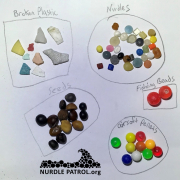
Have you heard people talking about nurdles? Nurdles are tiny plastic pellets used as the raw material to make almost everything plastic, and they are washing up on shorelines, floating down rivers, and accumulating in lakes and along railroads? The pellets are made and stored in large silos, then blown into railcars, trucks, or put in Gaylord sacks or large bags where they are shipped all over the country, and world. The nurdles are small and light weight, which makes them hard to contain. When loading and offloading the nurdles, they can fall out on the ground. During transportation of the nurdles along railroads or truck, the pellets can leak out on to the ground. Actually, pellets can be lost at every point along the supply chain, and even at the final destination where they will be melted down and made into a final plastic product like a toy, water bottle, grocery bag, computer, car part, etc. Once the nurdles are on the ground, rain can carry them downstream to the nearest river, then to the bays, and ultimately to the ocean where they will then end up washing up on beaches. You might ask what is bad about the nurdles? Once the nurdles are in the water, they absorb harmful chemicals such as PCBs, DDTs, and PAHs. The pellets also look like food to animals where birds, turtles, and fish can eat them, causing behavioral changes and even death from starvation.
In an effort to find where these plastic pellets are coming from, Nurdle Patrol was started, which is a citizen science project initiated by the Mission-Aransas National Estuarine Research Reserve at the University of Texas Marine Science Institute, and run by over 25 partners across the United States and Mexico. Volunteers conduct 10 minute surveys along the high tide line, then upload the number of nurdles they found into an online form at www.NurdlePatrol.org. After the data is entered, a nurdle map on the website will show the data point along with all the other data collected around the country, painting a picture of where the highest concentration of nurdles is being found. We are hoping the state and federal regulatory agencies are using the data to further investigations and creating stricter stormwater permit regulations that help prevent pellets from getting out into the environment. Nurdle Patrol supplies data and key statistics on a monthly basis to regulatory agencies. The Nurdle Patrol Facebook page has posts daily from around the country of what people are finding and where, plus any new news that comes out regarding nurdles.
To help Nurdle Patrollers identify nurdles from similar items, we created this simple chart that shows the difference between nurdles, broken plastic pieces, seeds, fishing beads, and airsoft pellets. The nurdles are hard, and most pellets being found are Low Density Polyethylene (LDPE) or Polypropylene (PP). We find these types of plastic due to their density in water and the ability to float. The denser plastics like PET, PVC, and HDPE are likely sinking to the bottom of where they enter the water system, and would not be floating long distances. We hope this simple to read chart helps Patrollers become experts in identifying nurdles on their next survey. Happy nurdling!


